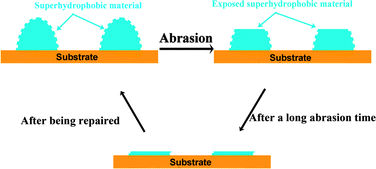Superhydrophobic surfaces have numerous applications in self-cleaning paints and windows, non-wetting fabrics, anti-icing, and so on. Many methods have been developed to fabricate superhydrophobic surfaces. However, the superhydrophobic surfaces prepared by these approaches possess poor surface mechanical properties, in particular poor wear resistance property. This has greatly hindered their application.
Researchers at the R&D Center of Lubricating and Protecting Materials of the Lanzhou Institute of Chemical Physics of the CAS have fabricated a superhydrophobic metal/polymer composite surface possessing both mechanical durability and easy repairability via a facile method.
The study demonstrated that the rough surface textures were retained and the surface still exhibited superhydrophobicity after mechanical abrasion. Moreover, the non-wetting property can be restored by an easy regeneration process when loss of superhydrophobicity occurs.
Amazingly, the created metal/polymer surface can be used as a finger touchable self-cleaning surface.Endowing the superhydrophobic surfaces with mechanical durability and easy repairability is hoped to offer a new avenue for extending the lifespan of superhydrophobic surfaces and will enable a wide range of new applications in the future.
The work has received support from the National Natural Science Foundation of China. The findings have been published in J. Mater. Chem. (J. Mater. Chem., 2011, 21, 15793–15797).

Schematic illustration of superhydrophobic surfaces with mechanical durability and easy repairability (Image by ZHANG Zhaozhu et al.)
.J. Mater. Chem.Paper
